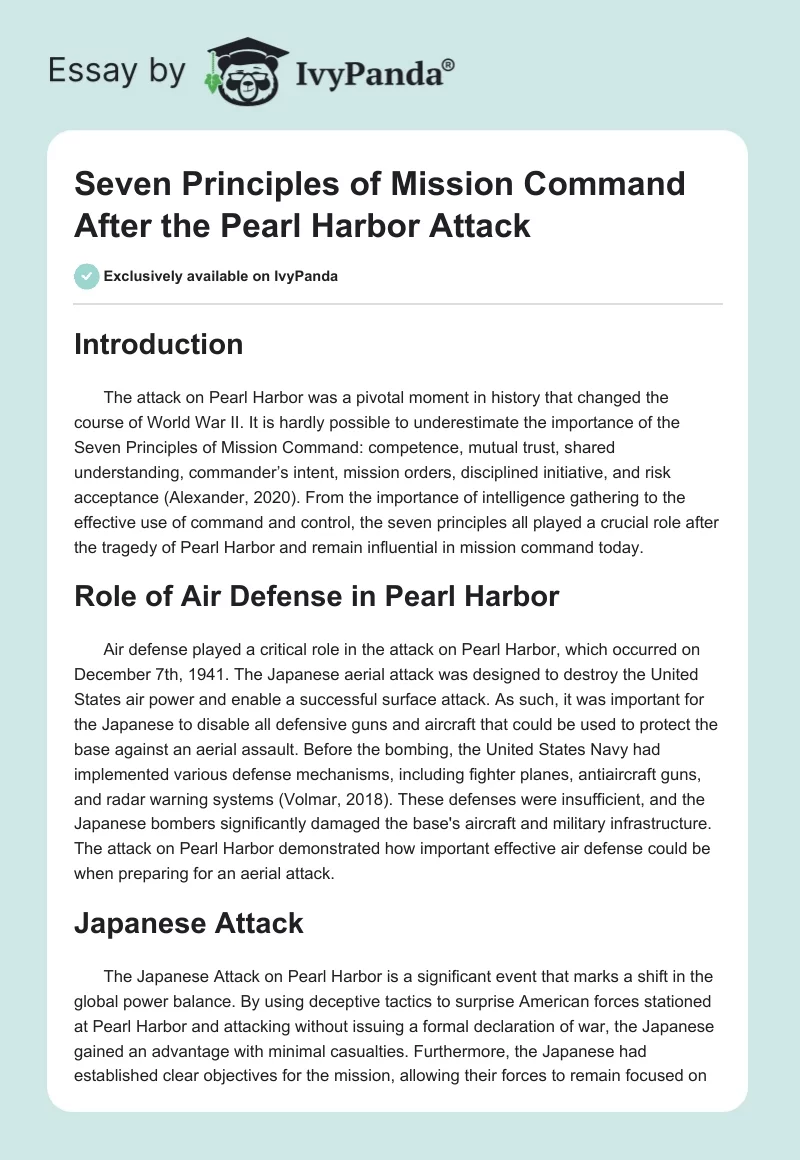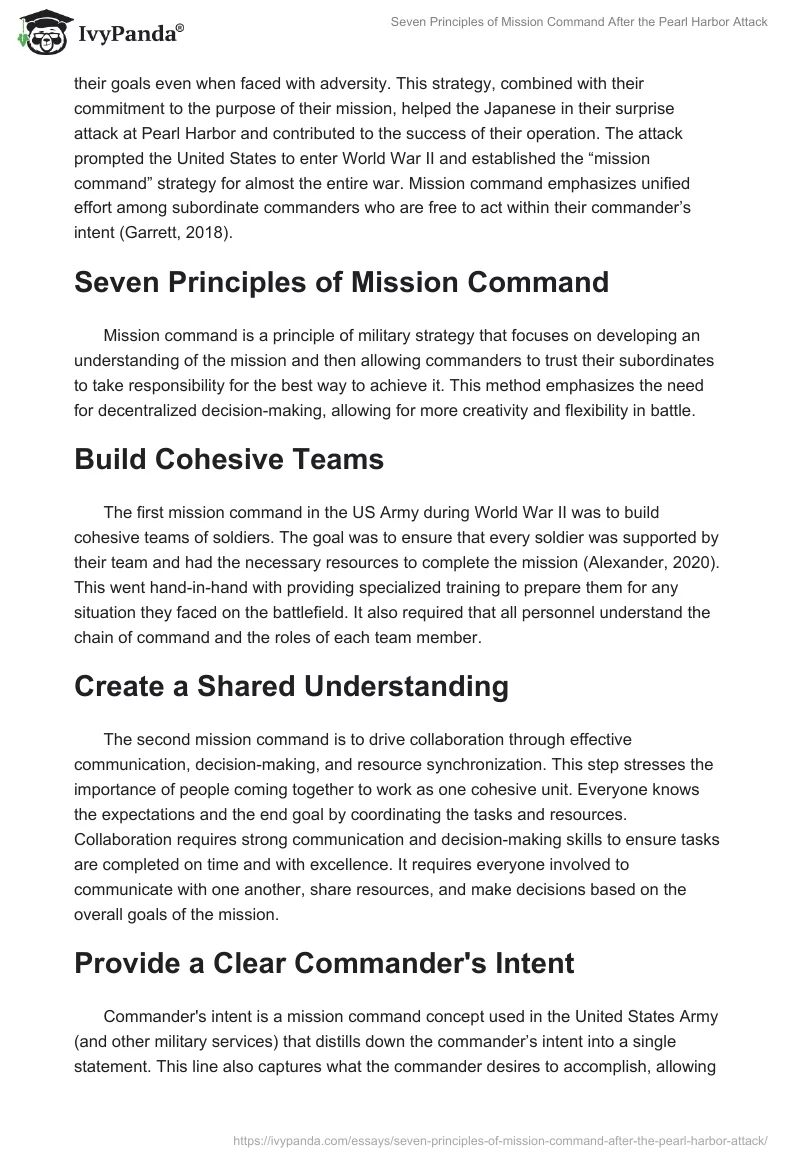Introduction
The attack on Pearl Harbor was a pivotal moment in history that changed the course of World War II. It is hardly possible to underestimate the importance of the Seven Principles of Mission Command: competence, mutual trust, shared understanding, commander’s intent, mission orders, disciplined initiative, and risk acceptance (Alexander, 2020). From the importance of intelligence gathering to the effective use of command and control, the seven principles all played a crucial role after the tragedy of Pearl Harbor and remain influential in mission command today.
Role of Air Defense in Pearl Harbor
Air defense played a critical role in the attack on Pearl Harbor, which occurred on December 7th, 1941. The Japanese aerial attack was designed to destroy the United States air power and enable a successful surface attack. As such, it was important for the Japanese to disable all defensive guns and aircraft that could be used to protect the base against an aerial assault. Before the bombing, the United States Navy had implemented various defense mechanisms, including fighter planes, antiaircraft guns, and radar warning systems (Volmar, 2018). These defenses were insufficient, and the Japanese bombers significantly damaged the base’s aircraft and military infrastructure. The attack on Pearl Harbor demonstrated how important effective air defense could be when preparing for an aerial attack.
Japanese Attack
The Japanese Attack on Pearl Harbor is a significant event that marks a shift in the global power balance. By using deceptive tactics to surprise American forces stationed at Pearl Harbor and attacking without issuing a formal declaration of war, the Japanese gained an advantage with minimal casualties. Furthermore, the Japanese had established clear objectives for the mission, allowing their forces to remain focused on their goals even when faced with adversity. This strategy, combined with their commitment to the purpose of their mission, helped the Japanese in their surprise attack at Pearl Harbor and contributed to the success of their operation. The attack prompted the United States to enter World War II and established the “mission command” strategy for almost the entire war. Mission command emphasizes unified effort among subordinate commanders who are free to act within their commander’s intent (Garrett, 2018).
Seven Principles of Mission Command
Mission command is a principle of military strategy that focuses on developing an understanding of the mission and then allowing commanders to trust their subordinates to take responsibility for the best way to achieve it. This method emphasizes the need for decentralized decision-making, allowing for more creativity and flexibility in battle.
Build Cohesive Teams
The first mission command in the US Army during World War II was to build cohesive teams of soldiers. The goal was to ensure that every soldier was supported by their team and had the necessary resources to complete the mission (Alexander, 2020). This went hand-in-hand with providing specialized training to prepare them for any situation they faced on the battlefield. It also required that all personnel understand the chain of command and the roles of each team member.
Create a Shared Understanding
The second mission command is to drive collaboration through effective communication, decision-making, and resource synchronization. This step stresses the importance of people coming together to work as one cohesive unit. Everyone knows the expectations and the end goal by coordinating the tasks and resources. Collaboration requires strong communication and decision-making skills to ensure tasks are completed on time and with excellence. It requires everyone involved to communicate with one another, share resources, and make decisions based on the overall goals of the mission.
Provide a Clear Commander’s Intent
Commander’s intent is a mission command concept used in the United States Army (and other military services) that distills down the commander’s intent into a single statement. This line also captures what the commander desires to accomplish, allowing subordinates to make decisions without consulting with higher levels of leadership (Alexander, 2020). It helps all involved parties understand the overall purpose of what they are trying to achieve, even when the details and context of the situation might change. It should be clear, concise, and easily understood by everyone.
Exercise Disciplined Initiative
The fourth mission command requires leaders to exercise disciplined initiative to adapt and adjust plans promptly when necessary. In ambiguous and unpredictable situations, it is essential for leaders to make quick and responsible decisions to succeed. Being able to think on one’s feet and accurately assess the situation while also being able to modify plans based on the given context can be a decisive factor in achieving goals and objectives.
Mission Orders
Mission orders are a mission command used by the US Army to provide clear and concise guidance to commanders. They clearly define task organization and give subordinates the necessary leeway to accomplish the mission. Mission orders are generally delivered in five parts: who, what, when, where, and why. The primary purpose of mission orders is to ensure that commanders have a common understanding of the mission’s purpose and that all forces involved are united in accomplishing the mission. However, the execution of tasks should not be specified to enhance creativity and freedom of action.
Accept Prudent Risk
The sixth mission command is to assume risk to seize opportunities. Taking risks, especially calculated ones, can present the leader with unforeseen outcomes that could lead to something greater than imagined. Thinking outside the box and taking a leap of faith can bring incredible rewards (Alexander, 2020). This mission command emphasizes the importance of considering all potential risks when making decisions and balancing those risks against potential rewards. Incorporating prudent risk into mission command can better mitigate risks from unexpected or unforeseen events. Prudent risk also allows leaders to understand their actions and remain flexible enough to react quickly to changing situations.
Develop a Culture of Trust
The US Army’s Culture of Trust mission command encourages leaders to trust their subordinates by giving them autonomy, freedom to make decisions without fear of failure, and a sense of purpose. It also emphasizes the importance of shared understanding among members, emphasizing communication, delegation, and clear objectives. Ultimately, it fosters a collaborative environment where all team members feel supported, respected, and valued for their contributions. This can ultimately lead to increased productivity and morale, as each member is confident in their roles, knowing their efforts are acknowledged and appreciated.
Conclusion
The Pearl Harbor attack is a harrowing reminder of the importance of the Seven Principles of Mission Command. The principles encompass competence, mutual trust, shared understanding, commander’s intent, mission orders, disciplined initiative, and risk acceptance, which significantly impacted the course of World War II and remain central components in mission command even today. The tragedy of Pearl Harbor has served as an essential lesson in recognizing the effect these principles can have on the outcome of any given mission.
References
Alexander, R. P. (2020). Mission command: The need for disciplined initiative. Army Command and General Staff College Fort Leavenworth.
Garrett, T. C. (2018). Mission command principles applied to paramilitary forces in Europe during the second World War. Army Command and General Staff College Fort Leavenworth.
Volmar, D. (2019). The Computer in the garbage can: Air-defense systems in the organization of US nuclear command and control, 1940-1960. [Doctoral dissertation, Harvard University].


